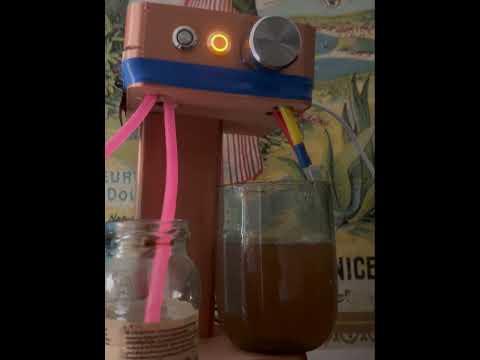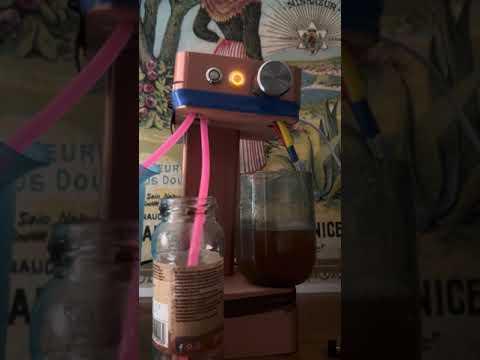Build Your Own Syrup Dispenser Machine
by TylerDDDD in Circuits > Arduino
1123 Views, 13 Favorites, 0 Comments
Build Your Own Syrup Dispenser Machine

This Instructable will guide you through building a custom syrup dispenser machine.
This device automatically dispenses water or a water-syrup mixture. It includes a button to adjust the syrup percentage, allowing you to control the sweetness from mild to strong.
The machine's body is custom-designed and 3D-printed, with laser-cut components for precision. The electronics are powered by an Arduino ESP32-WROOM-DA with a custom program, and the pumps are 12V DC-powered.
Let’s get started!
Supplies

Materials Needed
- 3D Printing & Laser Cutting:
- 3D printer (FDM or SLA)
- Laser cutter
- PLA or ABS filament for 3D printing
- Acrylic sheets for laser cutting
- Electronics:
- Arduino ESP32-WROOM-DA
- Custom PCB (optional for tidy wiring)
- 12V DC water pump (2 units)
- Power supply (12V, 2A minimum)
- Push button (2 units)
- 12V power supply
- Potentiometer or rotary encoder (optional for fine-tuning)
- One 12V relay module
- Optional : OLED screen
- Wires, connectors, and a soldering kit
- Miscellaneous:
- Tubing (food-grade) for water and syrup
- Syrup and water reservoirs (bottles or containers)
- Fittings to secure tubing
- Screws and nuts for assembly
- Tools (screwdrivers, pliers, etc.)
Note : the links are part of the Amazon associates program.
Design and Print the Body


If you want to start from scratch, you need to :
- Use CAD software like Fusion 360 or TinkerCAD to design the machine's body.
- Include slots for the pumps, Arduino, button, and tubing.
- Design mounting points for secure placement of electronics and reservoirs.
- Export the design files and 3D print the body components.
- For any flat panels or decorative elements, use a laser cutter to cut acrylic sheets based on your design.
You can also use my designs on GitHub :
- box_bottom.stl
- box_middle.stl
- box_pipe.stl
- box_top.stl
- box_top_trou.stl
In that case just you have to download the files, slice them with Cura, and load the gcode files on your 3d printer.
Assemble the Electronics



Follow those steps :
- Connect the pumps to the Arduino via the relay module.
- One pump will handle water.
- The second pump will handle syrup.
- Wire the push button to an input pin on the Arduino.
- Program the button to cycle through syrup strength levels (e.g., low, medium, high).
- Power the pumps using the 12V power supply.
- (Optional) Design a custom PCB to neatly organize the connections.
The pinout connections are commented in the Arduino Code at the beginning of the program :
Programming the ESP32


Steps to follow :
- Download the Arduino Code from GitHub : file CocktailMachine.ino.
- Use the Arduino software to compile and upload the code to the ESP32 board.
Many documentation on internet explain how to use the Arduino software.
Copy of the code, that is also available on GitHub :
Final Assembly


Follow the steps below :
- Install the pumps, Arduino, and button into the 3D-printed body.
- Connect the tubing from the reservoirs to the pumps and then to the output spout.
- Secure all components using screws or adhesive as necessary.
- Test for leaks and ensure all connections are tight.
Testing and Calibration

Try and adjust :
- Fill the water and syrup reservoirs.
- Power on the machine.
- Test the button to adjust syrup strength and observe the output.
- Fine-tune the program if necessary to adjust timings or flow rates.
Congratulations! You’ve built your own syrup dispenser machine. Enjoy crafting perfectly mixed beverages!
Next Steps
As future build, this machine could be enhanced to propose more than one syrup. Also a cocktail machine could also be developed..